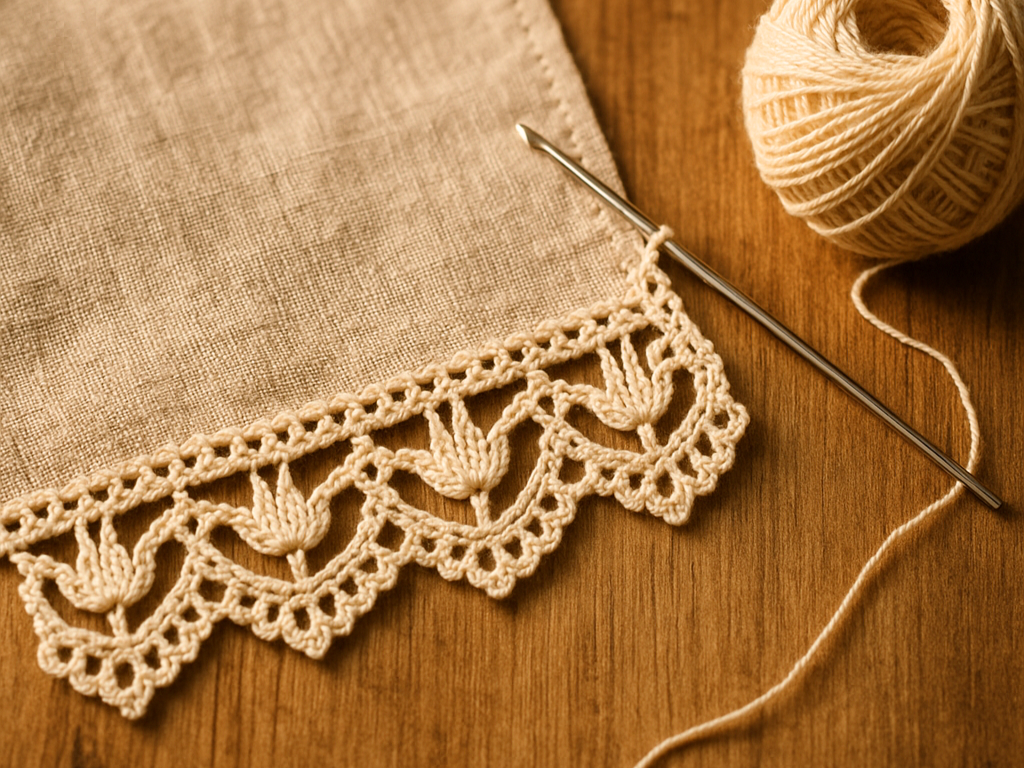#HistoryStitch: Ottoman Edgings & European Lace – how Oya borders informed church & court lace

When we think of Ottoman textile art, we see floral arabesques, tulips, and carnations – motifs that survived for centuries on fabrics, embroideries, and lace borders. Under the umbrella term Oya (Turkish for fine lace/edging), narrow decorative trims were created in Anatolia and the Ottoman Empire – as needle lace (iğne oyası), crochet trims (tığ oyası), tatting and more. This Oya culture is deeply rooted and was used for headscarves, garments, and household linens – a visual "language system" with symbolic flower motifs.
🕌 Historical Note
The term "crochet" is clearly documented in Europe only from the 19th century onwards. Earlier edge work from the 16th–17th centuries was mostly needle lace or other looped/knotting techniques. Many "early crochet" finds were later identified as nålebinding or needle lace. So for around 1600 we accurately speak of lace/edging techniques – with Oya as a tradition covering several tools (needle, hook, shuttle).
📜 The Mediterranean as Exchange Zone: From Istanbul to Venice & Flanders
Venice and the Ottoman Empire were closely linked trading and cultural partners in the 15th–16th centuries. Through these hubs, motifs, silks, embroideries, and edging aesthetics traveled – and inspired Italian and Flemish lace centers (Burano, Alençon, Flanders). Exhibitions and scholarship make this bidirectional influence clear.
In Europe, demand for needle lace exploded in the 17th century. Venetian "punto in aria" / Point de Venise set the tone with plastic floral/scroll borders – a repertoire that stylistically corresponds to Ottoman floral motifs (tulips, carnations). Liturgical vestments and courtly garments were lavishly edged with them. (Examples: Burano's heyday ca. 1620–1710; Venetian borders on ecclesiastical garments in many museum collections.)
Research insight: Catalogues such as "The Sultan's Garden – The Blossoming of Ottoman Art" demonstrate how the Ottoman flower repertoire (especially the tulip) shaped the arts – a transfer of motifs that European lace and embroidery designers picked up.
🔎 Oya in Detail: Technique & Symbolism
Techniques: iğne oyası (needle lace, often 3D flowers), tığ oyası (crochet edge), mekik oyası (tatting). All belong to the Oya family of narrow decorative borders.
-
Context: Oya served as communicative ornament – flowers stood for feelings/occasions; edgings decorated scarves, shirt hems, and linens.
🧭 What Does This Mean for "Christian Lace"?
Church textiles of the 17th century (albs, rochets, chasubles) were edged in Italy/Flanders with wide needle lace borders. In these relief scrolls and floral rolls we find formal parallels to Ottoman floral motifs (tulip-like blossoms, elongated calyxes, S-scrolls). The exchange through trade (silks, pattern books, drawings) is well documented. A direct 1:1 "copy" is rarely provable – but stylistic adoption and adaptation certainly occurred.
📚 Pattern Books & Reconstructions
Original design albums (e.g. Islamic ornament scrolls such as the Topkapı Scroll) show geometric-floral frameworks that also inspired lace fillings. Today, museums and workshops reconstruct Venetian needle lace from historic border designs – and Oya masters revive traditional floral edging motifs in both needle and crochet form.
🛠️ Practical Transfer (Modern & Doable)
For crochet or knitting projects these historical ideas can be beautifully reinterpreted:
-
Small modern Oya crochet edging: chain arches + picots, with tiny "tulips" (3D clusters) at intervals – perfect for scarves, shawls, or children's dresses.
-
Knitted relief "baroque flower": a narrow border with mini-cables + lace fillings as a nod to Point de Venise relief – great for hems or sleeve finishes.
💛 My Takeaway:
The Ottoman Oya tradition (as needle, crochet, and tatting edges) and the Mediterranean exchange provided Europe's lace centers with floral border ideas: arabesques, rhythmic scrolls, sculpted blossoms. While crochet as a defined technique was only securely established later, Ottoman border aesthetics already shaped European needle lace design in the 16th–17th centuries – visible in church vestments and court fashion. Anyone who reinterprets Oya motifs today ties into this cross-cultural design history.
💬 Feeling inspired?
Try a delicate Oya trim in natural shades on your next project – and share your results with the community. 💬🧶
#strickenimtrend #maschenmitliebe #HistoryStitch #OyaLace #VenetianLace
So it becomes clear that even the finest threads can serve as bridges – connecting cultures, centuries, and our modern world of needlecraft.
Warmly,
Kathrin 🧶
Want to dive deeper into the world of stitches?
Explore my patterns, browse the blog, or join our community!
